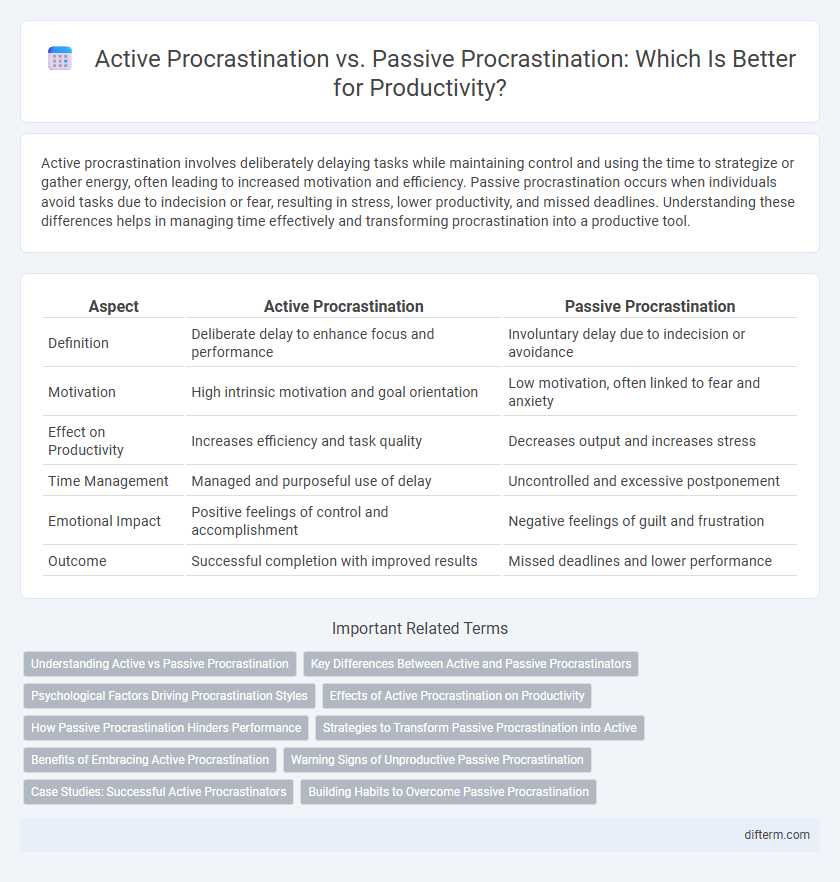Active procrastination involves deliberately delaying tasks while maintaining control and using the time to strategize or gather energy, often leading to increased motivation and efficiency. Passive procrastination occurs when individuals avoid tasks due to indecision or fear, resulting in stress, lower productivity, and missed deadlines. Understanding these differences helps in managing time effectively and transforming procrastination into a productive tool.
Table of Comparison
| Aspect | Active Procrastination | Passive Procrastination |
|---|---|---|
| Definition | Deliberate delay to enhance focus and performance | Involuntary delay due to indecision or avoidance |
| Motivation | High intrinsic motivation and goal orientation | Low motivation, often linked to fear and anxiety |
| Effect on Productivity | Increases efficiency and task quality | Decreases output and increases stress |
| Time Management | Managed and purposeful use of delay | Uncontrolled and excessive postponement |
| Emotional Impact | Positive feelings of control and accomplishment | Negative feelings of guilt and frustration |
| Outcome | Successful completion with improved results | Missed deadlines and lower performance |
Understanding Active vs Passive Procrastination
Active procrastination involves deliberately delaying tasks while maintaining control and motivation to meet deadlines, leveraging short bursts of intense focus. Passive procrastination, in contrast, occurs when individuals avoid tasks due to indecision or lack of self-regulation, leading to missed deadlines and reduced productivity. Understanding the distinction between these types helps in developing strategies that harness proactive delay without compromising work quality.
Key Differences Between Active and Passive Procrastinators
Active procrastinators strategically delay tasks to work more efficiently under pressure and often meet deadlines successfully, while passive procrastinators avoid responsibilities due to indecision and fear, resulting in missed deadlines and increased stress. Active procrastinators maintain motivation and control, leveraging their delay as a conscious choice, whereas passive procrastinators experience anxiety and lack of motivation, leading to procrastination as a coping mechanism. Understanding these behavioral patterns highlights the impact of intentionality and emotional regulation on productivity outcomes.
Psychological Factors Driving Procrastination Styles
Active procrastination involves deliberately delaying tasks with the intention of using the pressure to boost focus and performance, driven by traits like confidence and time management skills. Passive procrastination stems from indecision, anxiety, or fear of failure, leading to avoidance and reduced productivity due to lack of motivation or self-regulation. Understanding these psychological factors helps tailor interventions to improve task completion and overall productivity.
Effects of Active Procrastination on Productivity
Active procrastination can enhance productivity by leveraging intentional delays to foster focus and creativity under pressure. This strategic postponement allows individuals to prioritize tasks effectively, leading to improved time management and goal achievement. Studies indicate that active procrastinators often report higher motivation levels and better performance compared to passive procrastinators.
How Passive Procrastination Hinders Performance
Passive procrastination significantly decreases productivity by causing individuals to delay tasks due to indecision or anxiety, leading to missed deadlines and increased stress levels. This behavior fosters a cycle of inactivity and reduced motivation, impairing cognitive function and creative problem-solving abilities. As a result, performance deteriorates, as tasks are completed hastily or not at all, negatively impacting overall goal achievement and work quality.
Strategies to Transform Passive Procrastination into Active
Passive procrastination often leads to missed deadlines and increased stress, while active procrastination involves intentional delay with a planned timeline. Strategies to transform passive into active procrastination include setting specific goals, breaking tasks into manageable steps, and utilizing time-blocking techniques. Implementing mindfulness practices and regular self-assessment improves awareness, helping to replace avoidance behaviors with purposeful action.
Benefits of Embracing Active Procrastination
Active procrastination involves intentionally delaying tasks while maintaining control over deadlines, leading to enhanced time management and reduced stress levels. Embracing active procrastination encourages prioritization of high-impact activities and boosts motivation by leveraging deadline pressure effectively. This approach improves overall productivity by transforming procrastination into a strategic tool for maximizing efficiency.
Warning Signs of Unproductive Passive Procrastination
Unproductive passive procrastination often manifests through chronic avoidance of tasks, resulting in missed deadlines and increased stress levels. Warning signs include frequent distraction by low-priority activities, persistent feelings of guilt or anxiety about unfinished work, and a lack of proactive planning or goal-setting. Recognizing these behaviors early can improve productivity by encouraging shifts toward active time management strategies.
Case Studies: Successful Active Procrastinators
Case studies of successful active procrastinators reveal that they strategically delay tasks to enhance creativity and decision-making under pressure. These individuals leverage the urgency created by procrastination to prioritize critical work, often resulting in improved productivity and innovation. Research indicates that active procrastinators consistently meet deadlines while maintaining high-quality output, distinguishing them from passive procrastinators who suffer from stress and missed deadlines.
Building Habits to Overcome Passive Procrastination
Active procrastination involves deliberately delaying tasks to work better under pressure, while passive procrastination results from indecision and avoidance, leading to decreased productivity. Building consistent habits such as prioritizing tasks, setting specific deadlines, and breaking projects into manageable steps effectively combats passive procrastination by creating structure and accountability. Habit formation triggers neuroplasticity, reinforcing disciplined behaviors that enhance focus and reduce avoidance tendencies.
Active procrastination vs passive procrastination Infographic

 difterm.com
difterm.com